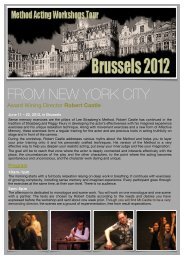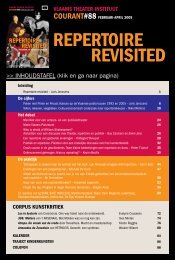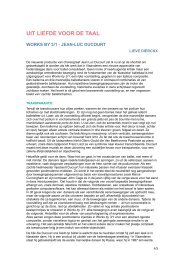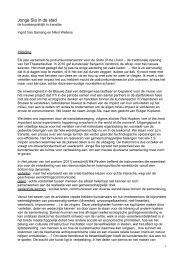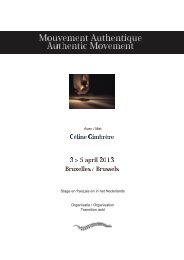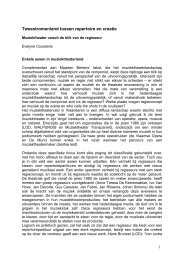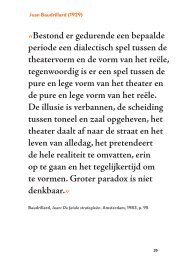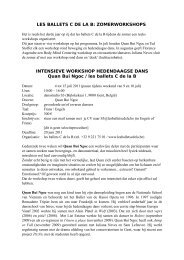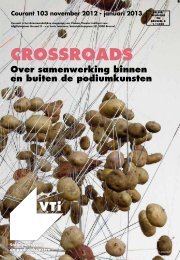music theatre in flanders - Muziekcentrum Vlaanderen
music theatre in flanders - Muziekcentrum Vlaanderen
music theatre in flanders - Muziekcentrum Vlaanderen
Create successful ePaper yourself
Turn your PDF publications into a flip-book with our unique Google optimized e-Paper software.
<strong>in</strong>g Arts Decree. But the list’s most strik<strong>in</strong>g feature is the diversity<br />
of the <strong>in</strong>volved organizations’ backgrounds. There is the Flanders<br />
Royal Ballet (Kon<strong>in</strong>klijk Ballet van <strong>Vlaanderen</strong>), that also produced<br />
<strong>music</strong>als dur<strong>in</strong>g the exam<strong>in</strong>ed period (the company actually<br />
closed its <strong>music</strong>al department <strong>in</strong> 2004). There are also the<br />
productions by dance companies such as Rosas and Les Ballets<br />
C de la B: not their entire production, but only the productions<br />
that worked with on stage live <strong>music</strong>. There is also the <strong>theatre</strong><br />
companies’ share: Ensemble Leporello, Victoria, HETPALEIS,<br />
Toneelhuis, Het Net... It should be noted that nearly all – Leporello<br />
is an exception – <strong>theatre</strong> companies have been <strong>in</strong>volved both<br />
as ma<strong>in</strong> producer and as co-producer. Toneelhuis, for <strong>in</strong>stance,<br />
co-produced Wayn Traub’s work dur<strong>in</strong>g the period.<br />
The list also shows a number of arts centres and festivals<br />
which work primarily as co-producer for – domestic ánd foreign<br />
– <strong>music</strong> <strong>theatre</strong> companies: Vooruit, Kaaitheater, deS<strong>in</strong>gel, Kunstenfestivaldesarts<br />
and Flanders Festival. A strik<strong>in</strong>g presence <strong>in</strong><br />
the list is Paris-based Théâtre de la Ville: this house does not<br />
primarily owe its high rank<strong>in</strong>g <strong>in</strong> the list to a partnership with<br />
<strong>music</strong> <strong>theatre</strong> companies <strong>in</strong> Flanders recognized as such, but<br />
to its year-long partnership with <strong>theatre</strong> and dance companies<br />
such as Rosas, Needcompany and Les Ballets C de la B. Further<br />
below is a list of the most active foreign co-producers.<br />
The top of the pyramid is, of course, only one side of the story.<br />
Diagram 2 only shows the <strong>music</strong> producers top twenty, represent<strong>in</strong>g<br />
only 4% of the organizations, but responsible for 41% of the<br />
entire production volume. In what follows, we shall take a closer<br />
look at the rise of co-production practice and the background of<br />
producers for the entirety of <strong>music</strong> <strong>theatre</strong> production.<br />
deVelOpInG CO-prOduCTIOn prACTICe<br />
Dur<strong>in</strong>g the period 1993-2005 the production mode of the perform<strong>in</strong>g<br />
arts drastically changed. In Metamorphoses a strong<br />
rise of co-production practice was noted as one of the most strik<strong>in</strong>g<br />
trends. Whereas the majority of the productions of the early<br />
1990s were made by s<strong>in</strong>gle organizations, today’s production <strong>in</strong>creas<strong>in</strong>gly<br />
takes place <strong>in</strong> a network environment – <strong>in</strong> co-operation<br />
with partners with a variety of backgrounds, domestic and foreign.<br />
This is a trend that began <strong>in</strong> the 1980s and that was probably <strong>in</strong>tensified<br />
s<strong>in</strong>ce the <strong>in</strong>troduction of the Arts Decree. A new edition<br />
of the field analysis, scheduled for mid-2011, is expected to give<br />
def<strong>in</strong>ite answers.<br />
In the meantime, it is plausible to say that co-production has<br />
become a regular practice <strong>in</strong> <strong>music</strong> <strong>theatre</strong> as much as <strong>in</strong> any<br />
other perform<strong>in</strong>g arts discipl<strong>in</strong>e. For the 1,038 productions, a total<br />
of 2,184 mentions of a (co-)producer can be counted.<br />
This means that, on average, just over two producers are<br />
<strong>in</strong>volved <strong>in</strong> a <strong>music</strong> <strong>theatre</strong> production. But averages can sometimes<br />
disguise considerable differences. That is why we th<strong>in</strong>k it<br />
is better to cluster the productions on the basis of the number of<br />
producers. Did co-production practice become <strong>in</strong>creas<strong>in</strong>gly frequent<br />
dur<strong>in</strong>g the exam<strong>in</strong>ed period? How do the averages <strong>in</strong> <strong>music</strong><br />
<strong>theatre</strong> relate to the entirety of the perform<strong>in</strong>g arts?<br />
20 21<br />
table of contents




